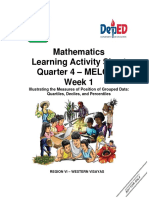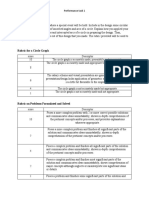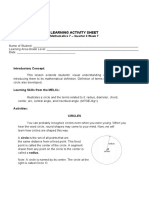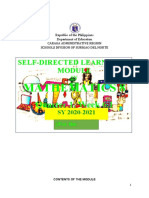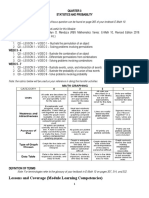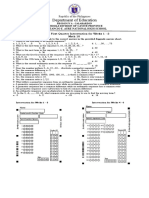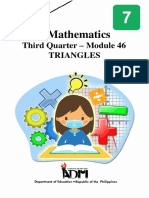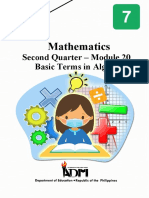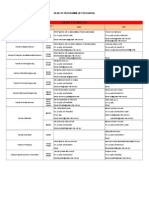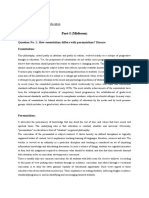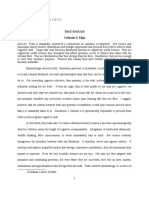Mathematics 8, Quarter 4 Week 8: Activity 1 Response All You Can!
Mathematics 8, Quarter 4 Week 8: Activity 1 Response All You Can!
Uploaded by
NylinamCopyright:
Available Formats
Mathematics 8, Quarter 4 Week 8: Activity 1 Response All You Can!
Mathematics 8, Quarter 4 Week 8: Activity 1 Response All You Can!
Uploaded by
NylinamOriginal Title
Copyright
Available Formats
Share this document
Did you find this document useful?
Is this content inappropriate?
Copyright:
Available Formats
Mathematics 8, Quarter 4 Week 8: Activity 1 Response All You Can!
Mathematics 8, Quarter 4 Week 8: Activity 1 Response All You Can!
Uploaded by
NylinamCopyright:
Available Formats
WEEKLY LEARNING ACTIVITY SHEET
Mathematics 8, Quarter 4 Week 8
FINDING THE PROBABILITY OF A SIMPLE EVENT
Name: __________________________________________ Section: ____________________
MELC: The learner finds the probability of a simple event. M8GE-IVh-1
Learning objectives
a. Applies fundamental counting principle in finding the number of
favorable and possible outcomes.
b. Recognizes the formula in finding the probability of a simple event
and the different probability rules.
c. Solves problems involving probability of a simple event.
d. Creates a model in solving real life situations related to simple
probability.
Time allotment: 4 days
Key concepts:
- Probability (pages 565, Mathematics 8 Learner’s Module)
- Probability is the chance that something will happen. Events cannot be
predicted with total certainty. We can say, “How likely they are to
happen.”
- Sometimes we can measure a probability with a number like "10% chance",
or we can use words such as impossible, unlikely, possible, even chance,
likely and certain. As a number, probability is from 0 (impossible) to 1
(certain).
Activity 1 RESPONSE ALL YOU CAN!
Relate each illustration below with your day to day activities. Fill in the blanks
with the correct words that would make the following sentences meaningful.
Author: EDGARDO B. TRUJELIO Reviewers: 1. DR. ROLAND S. CAPALAR
School/Station: Mahay Integrtaed Secondary School 2. RARIUS F. PABIA
Division: Butuan City
Email address: edgardo.trujelio001@deped.gov.ph
1. To God, nothing is ________________.
2. Don’t be afraid to take another _________________.
3. I’m ___________ that you can do better than what is expected of you.
4. Both men and women have ________________ chance to succeed in life.
5. Now is your _____________________ to change for the better.
Questions:
a. Are you familiar with those words?
b. What particular concept comes to your mind when you see the words in
the illustration?
c. What qualitative terms can be used to express probable occurrences of
events in life?
d. How else can the possible occurrence or likelihood of an event be
expressed?
e. Based on the illustration, how do you describe probability?
You just tried defining probability which is the possibility of occurrences of
events in a man’s life, which can be expressed as a fraction, a decimal or a percent.
As you move on to the next activity, your prior knowledge on the basic concepts of
probability and the fundamental counting principles will be elicited.
Activity 2 BUDGET REALLY MATTERS!
Use the illustration below to answer the following questions correctly.
1. How many shirts are there? _____
2. How many pairs of short pants are there? _____
3. How many pairs of long pants are there? _____
4. If you will attend a party, how many choices are possible? _____
5. If you are going to attend the mass with your family, how many possible
outfits could you choose from? How did you arrive at your answer? _____
Author: EDGARDO B. TRUJELIO Reviewers: 1. DR. ROLAND S. CAPALAR
School/Station: Mahay Integrtaed Secondary School 2. RARIUS F. PABIA
Division: Butuan City
Email address: edgardo.trujelio001@deped.gov.ph
Questions:
1. How else can you find the number of possible outcomes?
2. Suppose you want to wear all those shirts and pairs of pants during vacation,
how many combinations are possible?
3. Did you find difficulty in choosing which to wear? Why?
4. Aside from comfort, what do you consider when you choose an outfit?
Do the next activity to explore further on the basic concepts of probability and
the fundamental counting principles.
Activity 3 LET’S ROLL IT!
Analyze the problem carefully. Fill in the table correctly and answer the
questions that follow. You are holding a die. Your seatmate is holding another die. If
both of you roll the dice at the same time, how many outcomes are possible?
Questions:
1. If you roll a die once, how many outcomes are possible? _______
2. What are those outcomes? _______
3. How do we call those outcomes? _______
4. Rolling two dice simultaneously, how many outcomes are possible? _______
5. How did you find the answer? ________
Life has a lot of uncertainties. Oftentimes, our decisions in life are done under
conditions of uncertainty. These are the probabilities of life.
Author: EDGARDO B. TRUJELIO Reviewers: 1. DR. ROLAND S. CAPALAR
School/Station: Mahay Integrtaed Secondary School 2. RARIUS F. PABIA
Division: Butuan City
Email address: edgardo.trujelio001@deped.gov.ph
Activity 4: WHAT IS THE PROBABILITY?
Probabilities can be solved theoretically in which each event is assumed to be
equally likely. Look carefully at the given set then match column A with column B.
Your answers will help you understand the concept on the probability of an event.
Given: Set R = {1,2,3,4,5 ,6 ,7,8,9,10,11,12}
Column A Column B
1 4 1
The probability of having: a. d. or
12 12 3
_____ 1. a 10
2 1 6 1
_____ 2. a 13 b. or e. or
12 6 12 2
_____ 3. odd numbers
3 1 0
_____ 4. even numbers c. or f. or 0
12 4 12
_____ 5. an odd number divisible by 3
_____ 6. an even number divisible by 3
Probability of Events
The probability of an event, P (event), is a number from 0 to 1 which tells how
likely the event is to happen.
Take a closer look at the probability line below.
Probability Rules
1. The probability of any event is a number (either a fraction, a
decimal or a percent) from 0 to 1.
Example: The weather forecast shoes a 70% rain
P(rain) = 70%
2. If an event will never happen, then its probability is 0.
Example: When a single die is rolled, find the probability of getting an
8. Sincethe sample space consist of 1, 2, 3, 4, 5, and 6, it is
impossible to get an 8.
0
Hence, P(8) = = 0.
6
3. If an event is sure to happen, then the probability is 1.
Author: EDGARDO B. TRUJELIO Reviewers: 1. DR. ROLAND S. CAPALAR
School/Station: Mahay Integrtaed Secondary School 2. RARIUS F. PABIA
Division: Butuan City
Email address: edgardo.trujelio001@deped.gov.ph
Example: When a single die is rolled, what is the probability of getting
a number less than 7?
Since all the outcomes {1, 2, 3, 4, 5, 6} are less than 7,
6
P (less than 7) = =1
6
4. The sum of the probabilities of all thesoutcomes in the sample space
is 1.
Example:
In rolling a fair die, each outcome in the sample space has a
1
probability of .
6
Hence, the sum of the probabilities of the outcomes is 1.
1 1
If a fair coin is flipped, P(T) = and P(H) = .
2 2
If you flipped the coin ten times and got the following outcomes: H, H, H, T,
H, T, T, H, H, H, what is the probability that the last outcome will also be a Head(H)?
How did you arrive at your answer?
𝐍𝐮𝐦𝐛𝐞𝐫 𝐨𝐟 𝐟𝐚𝐯𝐨𝐫𝐚𝐛𝐥𝐞 𝐨𝐮𝐭𝐜𝐨𝐦𝐞𝐬
P(event) =
𝐍𝐮𝐦𝐛𝐞𝐫 𝐨𝐟 𝐚𝐥𝐥 𝐩𝐨𝐬𝐬𝐢𝐛𝐥𝐞 𝐨𝐮𝐭𝐜𝐨𝐦𝐞𝐬
Examples:
1. What is the probability of getting a HEART from a deck of cards?
13 1
P (heart) = =
52 4
2. There are 25 marbles in a container: 4 are red, 5 are blue and 11 are
yellow. What is the probability that a blue marble will be picked?
5 1
P (blue marble) = =
20 4
Sometimes, getting an event affects the outcome of another event. Take a look
at these examples:
1. Five red candies are left in a bag of 40 different colored candies.
a. What is the probability that you will get a red candy?
How did you get your answer?
Author: EDGARDO B. TRUJELIO Reviewers: 1. DR. ROLAND S. CAPALAR
School/Station: Mahay Integrtaed Secondary School 2. RARIUS F. PABIA
Division: Butuan City
Email address: edgardo.trujelio001@deped.gov.ph
b. What are your chances of getting a red one when you pick again?
Do you have the same answer? Why?
How many candies are now in the bag?
How many red candies are there?
Getting the next candy is affected by the result of the first attempt. Every
time you get a piece of candy from a bag, the chance of getting a red one
will change. These are called dependent events.
2. Flipping a Coin
a. When you flip a coin, what is the probability of heads
landing up?
b. If you flip it again, what is the probability of getting tails?
The two events do not affect each other. They are independent
events.
Activity 5: SEE MY PROB-ABILITY!
Solve the following carefully, then write the correct answer on the space
provided before each number.
_____ 1. Ear Darenz is asked to choose a day from a week. What is the
probability of choosing a day which starts with S?
_____ 2. Choosing a month from a year, what is the probability of selecting a
month with 31 days?
_____ 3. If a letter is chosen at random from the word PERSEVERANCE, what
is the probability that the letter chosen is E?
_____ 4. If one letter is chosen at random from the word TRUSTWORTHY,
what is the probability that the letter chosen is a consonant?
_____ 5. The sides of a cube are numbered 11 to 16. If Jan Renz rolled the
cube once, what is the probability of rolling a composite number?
_____ 6. A box contains 7 red balls, 5 orange balls, 4 yellow balls, 6 green balls and 3
blue balls. What is the probability of drawing out an orange ball?
_____7. Of the 45 students in a class, 25 are boys. If a student is selected at random for
a field trip, what is the probability of selecting a girl?
_____ 8. Two fair coins are tossed simultaneously, what is the probability of showing tail
(T) first and head (H) next?
_____ 9. A spinner is divided equally and numbered as follows: 1, 1, 2, 3, 3, 4, 1, 1, 2, 4,
1,2, 3, 4, 1, 2. What is the probability that the pointer will stop at an even prime?
_____ 10. What is the probability of getting an 8 from a deck of 52 cards?
Activity 6: LET’S MAKE AN ACTIVITY TOGETHER
(Group Activity)
Author: EDGARDO B. TRUJELIO Reviewers: 1. DR. ROLAND S. CAPALAR
School/Station: Mahay Integrtaed Secondary School 2. RARIUS F. PABIA
Division: Butuan City
Email address: edgardo.trujelio001@deped.gov.ph
Gather data on the number of typhoons that hit the country in the previous
year. Using the basic concepts of probability, come up with a report showing the
estimated chances of a typhoon hitting the country for each month.
The report should contain the following:
1. Representation of collected data.
2. Process of coming up with the estimated probabilities.
3. Explanation on what type of probabilities is generated in the task.
Rubric for the Written Group Report
4 3 2 1
Representation Is complete, Is complete Is complete Is incomplete
of Data and organized and but and
Explanation and clear organized disorganized disorganized
Process/ Has correct & Has correct Has Has no
Computation appropriate illustration or illustration or illustration
illustration or solution with solution but or solution
solution minor errorr has errors
Reflection:
In this module, you learned concepts which helped you accomplished the different tasks successfully. This
time, kindly answer this activity which would show how important this module is in your day – to - day activities by
completing the open-ended statement below.
I can use the basic concepts of probability and the fundamental counting
principles in my day to day activities by _____________________________
__________________________________________________________________________________
__________________________________________________________________________________
__________________________________________________________________________________
__________________________________________________________________________________
__________________________________________________________________________________
__________________________________________________________________________________
__________________________________________________________________________________
__________________________________________________________________________________
References:
Acelajado, Maxima J. ( 2008 ). Intermediate Algebra. pp.319 -326. Makati City,
Philippines. Diwa Learning Systems Inc.
Glencoe/McGRAW-HILL. (1986). Mathematics Skills for Daily Living. pp. 397 - 411.
United States of America. Laidlaw Brothers, Publishers.
Author: EDGARDO B. TRUJELIO Reviewers: 1. DR. ROLAND S. CAPALAR
School/Station: Mahay Integrtaed Secondary School 2. RARIUS F. PABIA
Division: Butuan City
Email address: edgardo.trujelio001@deped.gov.ph
Price, Jack/ Rath, James N./ Leschensky, William.(1989). Pre- Algebra, A Problem
Solving Approach. pp. 420 – 430. Columbus, Ohio. Merrill Publishing Co.
WEBSITE LINKS
math_teachers_guide_11.pdf
Copyright 2011MathsIsFun.com
www.mathsisfun.com/definitions/probability.html
These sites provide the picture of the probability line and definitions of the basic
concepts.
http://intmath.com/counting-probability/2-basic-principles-counting.php
This site provides the picture for Activity 2, notes/tips on the basic counting
principles.
http://whatis.techtarget.com/definition/probability
This site provides the definition of probability and other concepts.
Answer Key
Author: EDGARDO B. TRUJELIO Reviewers: 1. DR. ROLAND S. CAPALAR
School/Station: Mahay Integrtaed Secondary School 2. RARIUS F. PABIA
Division: Butuan City
Email address: edgardo.trujelio001@deped.gov.ph
You might also like
- Mathematics: Quarter 3: Week 4 (Week 6) Learning Activity SheetDocument6 pagesMathematics: Quarter 3: Week 4 (Week 6) Learning Activity SheetOlivia Mae RigorNo ratings yet
- Second Quarter - Module 35: MathematicsDocument23 pagesSecond Quarter - Module 35: MathematicsNylinamNo ratings yet
- Measurement Second Quarter - Module 15: MathematicsDocument30 pagesMeasurement Second Quarter - Module 15: MathematicsNylinamNo ratings yet
- Risk Acceptability According To The Social SciencesDocument13 pagesRisk Acceptability According To The Social SciencesGonzalo MoyanoNo ratings yet
- Math 10 Module - Q3, WK 6Document9 pagesMath 10 Module - Q3, WK 6Reygie FabrigaNo ratings yet
- Math 8-Q4-Module-7Document15 pagesMath 8-Q4-Module-7Melanie RaymundoNo ratings yet
- Mathematicslearning Activity Sheet: Quarter 2 - Melc 8 Week 6Document7 pagesMathematicslearning Activity Sheet: Quarter 2 - Melc 8 Week 6Ramil J. MerculioNo ratings yet
- Math 10 Mod8Document16 pagesMath 10 Mod8Rochelle OlivaNo ratings yet
- Permutation: Can You Show Me The Way?Document5 pagesPermutation: Can You Show Me The Way?Rey Cabrido RoseteNo ratings yet
- G10LAS Q3 Week 6 Illustrates Events and Union and Intersection of Events PDFDocument4 pagesG10LAS Q3 Week 6 Illustrates Events and Union and Intersection of Events PDFJomar Dominguez Crizolo100% (1)
- Mathematics: Quarter 1 Week 5Document10 pagesMathematics: Quarter 1 Week 5Jerome BumagatNo ratings yet
- Fourth Periodical Test in Math 10 2019 2020Document5 pagesFourth Periodical Test in Math 10 2019 2020Jaycelyn Magboo BritaniaNo ratings yet
- Semi-Detailed Lesson PlanDocument4 pagesSemi-Detailed Lesson PlanSheine Nasayao MatosNo ratings yet
- Mathematics: Whole Brain Learning System Outcome-Based EducationDocument25 pagesMathematics: Whole Brain Learning System Outcome-Based EducationRachel Yam 3nidadNo ratings yet
- Math10 - Quarter 3 - Week 5 - Module 5: Page - 1Document4 pagesMath10 - Quarter 3 - Week 5 - Module 5: Page - 1gabrielbenedict fauniNo ratings yet
- Math 10 - Q3 M4Document11 pagesMath 10 - Q3 M4Dizzi Dzen MendozaNo ratings yet
- Math7 q2 Mod1of8 Approximating-MeasurementDocument25 pagesMath7 q2 Mod1of8 Approximating-MeasurementIrene Gemida-Apduhan TaguicNo ratings yet
- Math 10 Q4 Week 5 Module 5Document5 pagesMath 10 Q4 Week 5 Module 5Lan CeNo ratings yet
- DLP (Ndkc-Ibed) in Grade 10Document4 pagesDLP (Ndkc-Ibed) in Grade 10cathline austriaNo ratings yet
- Mathematics Activity Sheet: Quarter 4 - Week 1 - 2Document6 pagesMathematics Activity Sheet: Quarter 4 - Week 1 - 2Lish MeremonteNo ratings yet
- Mathematics 8 Q1-M11Document27 pagesMathematics 8 Q1-M11DanielIsaacAve75% (4)
- Grade 10 Daily Lesson Log School Grade Level 10 Teacher Learning Area MATHEMATICS Quarter SecondDocument14 pagesGrade 10 Daily Lesson Log School Grade Level 10 Teacher Learning Area MATHEMATICS Quarter SecondMichael Beniga100% (1)
- Mathematics 7 Module 1 Lesson 2 Polynomials Pre-Requisite Concepts: Constants, Variables, Algebraic ExpressionsDocument3 pagesMathematics 7 Module 1 Lesson 2 Polynomials Pre-Requisite Concepts: Constants, Variables, Algebraic Expressionsdorris09No ratings yet
- 4.determines Arithmetic Means and NTH Term of An Arithmetic Sequence SSP - M10AL Ia 3 B 1Document1 page4.determines Arithmetic Means and NTH Term of An Arithmetic Sequence SSP - M10AL Ia 3 B 1Justiniano SalicioNo ratings yet
- Math 10Document6 pagesMath 10Mhyr Pielago CambaNo ratings yet
- Math8 q2 Mod3of7 Domain-range-And-linear-functions v2Document26 pagesMath8 q2 Mod3of7 Domain-range-And-linear-functions v2Castillo, Juench M.No ratings yet
- Math10 Q3 Module30Document25 pagesMath10 Q3 Module30Reliza SamijonNo ratings yet
- Q4LAA10Document17 pagesQ4LAA10Fiestada Laylo Gerald100% (1)
- Mathematics: Quarter 2 - Module 6: Solving Problems Involving CirclesDocument16 pagesMathematics: Quarter 2 - Module 6: Solving Problems Involving CirclesJay Vincent Macadangdang100% (1)
- 16.3 Distinguishable PermutationsDocument23 pages16.3 Distinguishable PermutationsPaula JanNo ratings yet
- Mini - Task (AS) : Subject MatterDocument5 pagesMini - Task (AS) : Subject MatterTiffany Joy Lencioco GambalanNo ratings yet
- MATH10 - Q3 - Module6 - Types, Unions and Intersection of Events - V3Document37 pagesMATH10 - Q3 - Module6 - Types, Unions and Intersection of Events - V3KARIZZA ABOLENCIA0% (1)
- GRADE 10 LAS 2 - MELC 1b - 4TH QUARTERDocument11 pagesGRADE 10 LAS 2 - MELC 1b - 4TH QUARTERnorlie canete100% (1)
- Math 8-Q4-Module-6Document14 pagesMath 8-Q4-Module-6Jeson GaiteraNo ratings yet
- Math 8 Q4 LAS 2 FinalDocument8 pagesMath 8 Q4 LAS 2 Finalroselyn.santillan77No ratings yet
- 3.0 Conic Sections Ellipses FCIT CompatDocument29 pages3.0 Conic Sections Ellipses FCIT CompatMykhaela Louize Gumban100% (1)
- G10 - DLL - First QuarterDocument85 pagesG10 - DLL - First QuarterSitty Salma Hadji AbbasNo ratings yet
- MATH 10 Q2 WEEKS 1 8 63 PagesDocument63 pagesMATH 10 Q2 WEEKS 1 8 63 PageskairaNo ratings yet
- DLP G10 Math - 1stDocument4 pagesDLP G10 Math - 1stanon_754485983No ratings yet
- File 6937824253513484478Document3 pagesFile 6937824253513484478Sam ting wongNo ratings yet
- Week 7 Math 7Document7 pagesWeek 7 Math 7Girlie Mae FloresNo ratings yet
- Mathematics Activity Sheet: Quarter 4 - Week 3 - 5Document8 pagesMathematics Activity Sheet: Quarter 4 - Week 3 - 5Lish MeremonteNo ratings yet
- DLL Math 10 Q2 D3Document5 pagesDLL Math 10 Q2 D3Carmina DuldulaoNo ratings yet
- Math 10 Quarter 3 Module 32Document23 pagesMath 10 Quarter 3 Module 32lilacNo ratings yet
- G10 DLP Q2 Week 10 Day 2Document7 pagesG10 DLP Q2 Week 10 Day 2RT MIASNo ratings yet
- Mathematics 8: Quarter 1, Week 6.1Document12 pagesMathematics 8: Quarter 1, Week 6.1Rock Quel Sotto Daluz-PullosNo ratings yet
- DLL 2ND Qtr. Objective 11Document5 pagesDLL 2ND Qtr. Objective 11Ben Zerep100% (1)
- Lessons and Coverage (Module Learning Competencies)Document15 pagesLessons and Coverage (Module Learning Competencies)Arnel Fontanilla Balbuena AmbrocioNo ratings yet
- The Equation of A Circle Part IDocument3 pagesThe Equation of A Circle Part Ineil balajadiaNo ratings yet
- Math 10 Quarter 3 Week 4Document7 pagesMath 10 Quarter 3 Week 4Sagayake SanNo ratings yet
- Department of Education: Republic of The PhilippinesDocument1 pageDepartment of Education: Republic of The PhilippinesDollie May Maestre-Tejidor100% (1)
- Mathematics: Quarter IV - Module 3Document18 pagesMathematics: Quarter IV - Module 3Marian IntalNo ratings yet
- Quarter 2 Week 5 Mathematics 10: ExpectationsDocument10 pagesQuarter 2 Week 5 Mathematics 10: ExpectationsZenaida CruzNo ratings yet
- Measure of The Position (Decile Ungrouped)Document7 pagesMeasure of The Position (Decile Ungrouped)KarenNo ratings yet
- Math10 Q4 M1Document15 pagesMath10 Q4 M1Aizel IbañezNo ratings yet
- Math 10 QTR 2 Week 4Document9 pagesMath 10 QTR 2 Week 4sim jay-hunNo ratings yet
- Worktext - Distance FormulaDocument9 pagesWorktext - Distance FormulaReygie FabrigaNo ratings yet
- Math8 - q1 - Mod9 - Solving Problems Involving Systems of Linear Equations in Two Variables - V3bedited2Document40 pagesMath8 - q1 - Mod9 - Solving Problems Involving Systems of Linear Equations in Two Variables - V3bedited2Gian Lalin100% (1)
- Q3 - 2ND Sum Test - Math 8Document7 pagesQ3 - 2ND Sum Test - Math 8Maridith Gabito Lulab CoynoNo ratings yet
- Permutation Vs CombinationDocument4 pagesPermutation Vs CombinationSaleh RehmanNo ratings yet
- Tangent and Secant SegmentsDocument5 pagesTangent and Secant SegmentsValiant DejañoNo ratings yet
- Probability of Simple EventDocument15 pagesProbability of Simple EventChloe Rose100% (1)
- Math 8 Q4 Week 8Document11 pagesMath 8 Q4 Week 8Eduardo Betco100% (1)
- TukDocument26 pagesTukNylinamNo ratings yet
- 16Document3 pages16NylinamNo ratings yet
- Mathematics7 Q3 M46 V4Document31 pagesMathematics7 Q3 M46 V4NylinamNo ratings yet
- Basic Terms in Algebra Second Quarter - Module 20: MathematicsDocument30 pagesBasic Terms in Algebra Second Quarter - Module 20: MathematicsNylinamNo ratings yet
- Math 7 Q3 Module 4Document24 pagesMath 7 Q3 Module 4Nylinam50% (4)
- Mathematics: Quarter 3 - Module 8Document22 pagesMathematics: Quarter 3 - Module 8Nylinam100% (1)
- In The Previous Lesson On It States That TDocument16 pagesIn The Previous Lesson On It States That TNylinam100% (1)
- Senior High School: First Semester S.Y. 2020-2021Document10 pagesSenior High School: First Semester S.Y. 2020-2021NylinamNo ratings yet
- Math7 Q4 SummativeTest WK7 8Document2 pagesMath7 Q4 SummativeTest WK7 8NylinamNo ratings yet
- Learning Objective:: Marygracelyn - Nagas@deped - Gov.phDocument8 pagesLearning Objective:: Marygracelyn - Nagas@deped - Gov.phNylinamNo ratings yet
- WLAS 9-Q4-W4v2Document9 pagesWLAS 9-Q4-W4v2NylinamNo ratings yet
- Senior High School: First Semester S.Y. 2020-2021Document8 pagesSenior High School: First Semester S.Y. 2020-2021NylinamNo ratings yet
- Math 8 - Q4 - AnswerKey - SummativeAssessment - WK5-6Document1 pageMath 8 - Q4 - AnswerKey - SummativeAssessment - WK5-6NylinamNo ratings yet
- Weekly Learning Activity Sheets Basic Concepts of ProbabilityDocument7 pagesWeekly Learning Activity Sheets Basic Concepts of ProbabilityNylinamNo ratings yet
- Tos Math9 q3wk1&2Document17 pagesTos Math9 q3wk1&2NylinamNo ratings yet
- Answer Key: Mathematics 8 Quarter 4 Summative Assessment For Weeks 3 & 4Document1 pageAnswer Key: Mathematics 8 Quarter 4 Summative Assessment For Weeks 3 & 4NylinamNo ratings yet
- Second Quarter - Module 19: MathematicsDocument30 pagesSecond Quarter - Module 19: MathematicsNylinamNo ratings yet
- DRRR - Q2 - Week 1Document14 pagesDRRR - Q2 - Week 1Nylinam67% (3)
- First Quarter - Module 9 Principal Roots of Rational Numbers and Irrational NumbersDocument33 pagesFirst Quarter - Module 9 Principal Roots of Rational Numbers and Irrational NumbersNylinamNo ratings yet
- Mathematics: Third Quarter - Module 42Document27 pagesMathematics: Third Quarter - Module 42NylinamNo ratings yet
- ObservationDocument3 pagesObservationkidsfunlandsNo ratings yet
- Jimma University College of Business and EconomicsDocument7 pagesJimma University College of Business and EconomicsTAMERATNo ratings yet
- Career: CornerDocument1 pageCareer: CornerJohn AnthoniNo ratings yet
- Kristan Cockerill, Melanie Armstrong, Jennifer Richter, Jordan G. Okie (Auth.) - Environmental Realism - Challenging Solutions (2017, Palgrave Macmillan)Document150 pagesKristan Cockerill, Melanie Armstrong, Jennifer Richter, Jordan G. Okie (Auth.) - Environmental Realism - Challenging Solutions (2017, Palgrave Macmillan)Oscar HoyosNo ratings yet
- Logical ReasoningDocument595 pagesLogical Reasoningynottrip100% (1)
- W. John Murray - Mental MedicineDocument74 pagesW. John Murray - Mental MedicineDr. FusionNo ratings yet
- Question BankDocument4 pagesQuestion BankSatish MudalagiNo ratings yet
- GT Lab Manual PDFDocument92 pagesGT Lab Manual PDFDharmaraaj RajalinggamNo ratings yet
- Rating ScalesDocument1 pageRating ScalesRadha NancooNo ratings yet
- 2A03 Week 1.1 and 1.2 Introduction To The Course 2Document259 pages2A03 Week 1.1 and 1.2 Introduction To The Course 2bobbyNo ratings yet
- List 3Document2 pagesList 3Yna VioletNo ratings yet
- Newtons Law of Gravitation SS2Document6 pagesNewtons Law of Gravitation SS2Nwoye ChinenyeNo ratings yet
- Foundations of Education, Mid Term SolvedDocument7 pagesFoundations of Education, Mid Term SolvedXee XeeNo ratings yet
- Computational Science and Numerical Methods-1Document30 pagesComputational Science and Numerical Methods-1daily feastNo ratings yet
- Research in Daily Life 2 (1st Prelim)Document3 pagesResearch in Daily Life 2 (1st Prelim)Love CHDCC100% (1)
- Approval SheetDocument3 pagesApproval SheetIannNo ratings yet
- Reflections On The Motive Power of FireDocument3 pagesReflections On The Motive Power of FireJames FranklinNo ratings yet
- ARDDIEDocument7 pagesARDDIEJill StassieNo ratings yet
- Literature Review Is Qualitative or QuantitativeDocument4 pagesLiterature Review Is Qualitative or Quantitativefvhacvjd100% (1)
- RESEARCH Chapter 6Document5 pagesRESEARCH Chapter 6tsegayeyayeleNo ratings yet
- Krippendorff - 2004 - Reliability in Content Analysis PDFDocument17 pagesKrippendorff - 2004 - Reliability in Content Analysis PDFFabiola ParmejaneNo ratings yet
- A Hybrid Delphi AHP Based Analysis of Construction Project Specific Success Factors in Emerging Markets The Case of EthiopiaDocument24 pagesA Hybrid Delphi AHP Based Analysis of Construction Project Specific Success Factors in Emerging Markets The Case of EthiopialoveahNo ratings yet
- Philosophical Issues 14 (2004), 113-121.: True Enough Catherine Z. ElginDocument31 pagesPhilosophical Issues 14 (2004), 113-121.: True Enough Catherine Z. ElginMatías Langenbach PobleteNo ratings yet
- Chi SquareDocument36 pagesChi SquareAkshay MathurNo ratings yet
- Research Methods in Education (8604) Ass 2 Anam Ashraf (BU619648)Document16 pagesResearch Methods in Education (8604) Ass 2 Anam Ashraf (BU619648)anam ashrafNo ratings yet
- MBA Students of 2016-18 BatchDocument11 pagesMBA Students of 2016-18 BatchRagini ChauhanNo ratings yet
- Testing of HypothesisDocument10 pagesTesting of HypothesisFa Kin NoowanNo ratings yet
- Action Research in EducationDocument47 pagesAction Research in EducationAnonymous GrK2HshwNo ratings yet
- J M Keynes and E. Borel's Initial Skipping of Part II of The A Treatise On Probability in His 1924 ReviewDocument31 pagesJ M Keynes and E. Borel's Initial Skipping of Part II of The A Treatise On Probability in His 1924 ReviewnetgerardoNo ratings yet
































